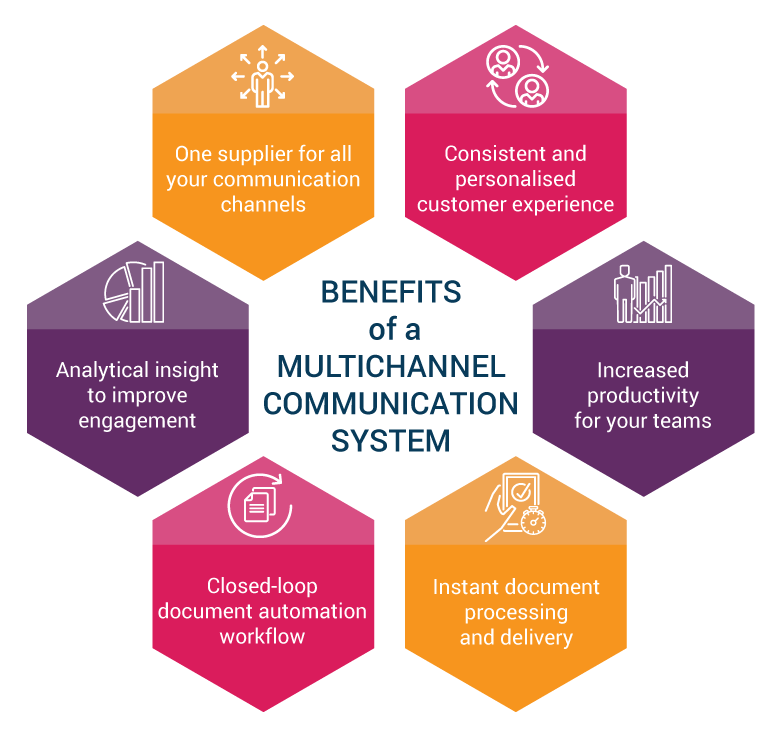Communicating with customers used to be simple: face-to-face, phone or email. Now people expect you to communicate with them through their preferred channel, including social media, instant messaging and web portals. This article will cover why multichannel communication is so important and the benefits of using a multichannel communication system.
We’re all well aware that we now live and operate in a predominantly digital world and have been for some time. For start-ups and small businesses, the ability to communicate in this digital world has appeared seamless. But for larger organisations with more traditional models and legacy systems, the transition has been more challenging.
Yet, the importance of engaging and motivating customers is essential for every organisation and in today’s digital world and competitive landscape, you need to communicate through multiple channels of communication: digital and physical. Providing a customer experience that spans more than one channel is vital.
Consider your customer experience across print, web, email, text and the other channels you use. Will you find success forcing customers to follow one channel? Or is the better solution to deliver a consistent experience via the channel of their choice?
Whilst it’s necessary to adapt to digital channels of delivery, it’s worth considering your customer profile. What channels do they use and need? If print is still part of the mix today, it will likely be tomorrow: albeit in lower numbers. So don’t discount this channel. Every channel is important.
If delivering multichannel communications is difficult, team up with a partner. A document automation partner can deliver communications via your customers’ channels of choice, without changing systems. It just needs a partner with automation solutions to complement what you do.
In this article, we’ll cover why multichannel communication is so important, an example of how a multichannel communication system works and the advantages of using such a system.
So before we start, let’s quickly highlight the six advantages of using a multichannel communication system (so you know why it’s worth reading on!):
- You’ll provide a consistent and personalised customer experience
- You’ll experience productivity gains, so you’ll have more time to focus on higher-value tasks
- You’ll get instant document processing and delivery
- You’ll benefit from a closed-loop document automation workflow
- You’ll receive reports and analytics to give you insight on how to improve engagement
- You’ll only need to work with one supplier to communicate through many channels

What is multichannel communication?
A multichannel communication definition is communicating and engaging with customers across multiple channels such as print, text, email, web portals, social media and mobile apps.
It means you need to present the same information, whether in a digital form or physical form.
Demand for multichannel communications is booming as businesses move away from telling their customers how important, time-critical information will be sent to designing customer journeys that put the customer’s channel(s) of choice first.
Why is multichannel communication so important?

Today, providing an excellent customer experience is vital and is often considered the key differentiator between competitors: ahead of product and price. And in our digital world, customers’ expectations are becoming more demanding. They want a social, mobile and ‘always-on’ experience from the organisations they interact with.
The demand for digital is consistently increasing, year on year and the adoption of newer methods of communication is outperforming more established forms, which is important to consider when reviewing your channel offering and your customer base.
The Online Nation report by Ofcom found that in April 2020, UK adults spent on average 4 hours and 2 minutes online every day. They also found that more people were sending daily messages using online messaging platforms (52%), such as WhatsApp and Facebook Messenger, than using SMS (41%) or email (26%).
But there is still a proportion of people who don’t have access to the internet or just prefer to receive communications in print. That’s why our motto at Datagraphic is to think digital-first, not digitally exclusive.
In 2020, UK adults spent on average 4 hours and 2 minutes online every day
With the pressure to present customer-facing documents digitally, some teams are deciding to only provide online access and remove printed documents entirely. Each organisation is different, so it could be the most effective and engaging way to deliver information to their customers. For others, a large percentage will prefer to receive a printed copy. At Datagraphic, we encourage our clients to offer a multichannel delivery and cater to the individual customer’s channel of choice.
It’s really important that as we focus our efforts on becoming more digital, we don’t want to exclude those who are unable to access information online or simply prefer to have paper copies of the important documents you send. You’ll see much better engagement with your communications if you give customers a choice.
So don’t stop thinking digital-first; just remember to consider those who might want or need print.
How does a multichannel communication system work?
There are many multichannel communication platforms available and they typically involve transferring or uploading data to be turned into interactive documents delivered across the different channels you select.
To give you a real example, here’s a quick overview of how Datagraphic’s Aceni, a multichannel communication system, works:

- Load your data/documents
Securely transfer your files from your existing systems to Aceni. Whether that’s a single letter or hundreds of thousands, Aceni can scale to your needs.
- Choose your channels
Confirm layouts and tell Aceni which templates to use and then choose one or many channels, and Aceni delivers the output. - Aceni delivers the output
Present digital eDocuments on secure web pages or within a secure web portal for those reoccurring documents. Notify people to view or take action on a document by email or text. Plus, Aceni automatically prints and posts documents to those who prefer physical mail. - Closed-loop multichannel service
Any digital communications sent can have an automatic print back-up. So, if someone doesn’t respond to an eDocument, Aceni can print and mail a copy to improve engagement. - Control and monitor your communications
Tell Aceni which documents you want to approve and set rules for Aceni to check and approve (or reject) others, making sure all your documents go out correctly to avoid any data breaches. Comply with legal deadlines and plan resources for response handling by monitoring when documents are produced and sent. - Reporting at your fingertips
Access reports and audit trails for document production, monitor spending and report on customer engagement.
By using a multichannel communication system to help to automate manual tasks, you’ll be able to communicate with your customers in the most effective and efficient way. You’ll save time and staff resource, as your team will be able to focus on more high-value work.
You’ll need a solution that can grow and scale with you as your customer base expands or where volumes fluctuate due to seasonal demands. You’ll also need a solution that can advance alongside new technology and easily switch between communication channels so you can deliver a seamless multichannel experience.
We highly recommend working with trusted third-party multichannel communication experts that can adapt and change as your business grows. Partnering with specialists from the outset will bring knowledge and experience across your project’s development, implementation, and growth. It removes the need to work or manage multiple suppliers and means you and your employees can concentrate on business and realise the benefits of multichannel communication will bring.
The advantages of a multichannel communication system
There are many advantages of a communication system to communicate with your customers, employees and suppliers, including competitive advantage and more efficient processes. But we’ve highlighted our top six benefits that we believe will provide the most value.
1. You’ll provide a consistent and personalised customer experience

Good multichannel communication software can consolidate data across different back-office systems and deliver consistent and tailored customer-facing documents across all your channels. Documents can contain individual or many data fields and contextual data: all personalised. Automation rules can also make sure extra documents and information are only added where relevant. Improve your customer experience and deliver relevant, timely and engaging communications on the channel of their choice.
2. You’ll experience productivity gains, so you’ll have more time to focus on higher-value tasks

The documents you send to customers are core to how your organisation operates, but are often not core responsibilities of your team, rather a business need. Multichannel communication systems automate fragmented, manual and repetitive processes, so your documents are produced and delivered more quickly and accurately. Now your teams have more time to focus on new projects, analyse customer data to provide insight into other business areas, all without having to worry about completing the repetitive, administrative task of document production and distribution.
3. You’ll get instant document processing and delivery

Turn your data into customer-facing documents, present them securely online in minutes, or print and mail them the same day.
Tasks, such as document production and distribution, that previously took your teams hours to complete can now take seconds or minutes to complete using automation solutions within a multichannel communication system.
4. You’ll benefit from a closed-loop document automation workflow

A full-service multichannel communication system should be able to offer a closed-loop document automation workflow. This is where you can automatically send follow-up communications and notifications via alternative channels to make sure your customers read the important documents you send.
For example, if you send a document that contains important information that needs action to a customer online via a secure personalised web page, and after three days you notice the document is still unread, a text or letter can be automatically sent to the person containing the same information. This means you can engage with your customers more effectively and efficiently.
5. You’ll receive reports and analytics to give you insight on how to improve engagement

Monitor costs, analyse engagement and improve future communications to increase customer engagement.
The multichannel communication system you use should follow highly auditable processes. For example, in-built controls and reporting options cover all the key things you need to know to inform your decision making. If you need to track a letter to respond to a customer query, this should be available from data upload to mail out. Or if you want to view online engagement to report on deliverability and open rates. And you should be able to report on spending and document delivery rates to share with management teams for budget reports.
6. You’ll only need to work with one supplier to communicate through many channels

Whether you’re printing and mailing information, sending text and email notifications or hosting documents securely online, having a multichannel communication system makes it much easier to manage.
There are third-party solutions available that can provide the secure end-to-end production and distribution of documents through all communication channels. This makes communicating with your customers straightforward, however, they like to be reached, as a single supplier can work with all of your communication channels. It also reduces the risk of a data breach as you are only transferring data to one supplier rather than sending data to many suppliers for different channel output.
Introducing Aceni – Datagraphic’s secure and integrated multichannel communications system
Aceni by Datagraphic is a multichannel communication platform that provides secure document automation for web, print, email and text communications.
A powerful productivity tool, it delivers scalable, end-to-end multichannel communications. All from one secure, controlled, GDPR compliant UK production and technology centre. It helps organisations and teams deliver digital transformation and document automation quickly, improve customer engagement and drive more positive outcomes whilst future-proofing processes to respond to changing needs and communication preferences.
What makes Aceni special?
Aceni is a unique multichannel communication system that automates, controls and delivers your outbound customer documents so you can achieve digital transformation in weeks. But what makes Aceni so special?
- Quicky to deploy – it can be accessed securely online, giving you instant access to upgrades and no software to install
- No licence fees – you only pay for the documents you output through Aceni, not per user or document click
- Early ROI – Aceni can be implemented in weeks not years, to reduce expenditure and achieve results much sooner
- Reduce non-compliance risks – meet regulatory and data protection needs by controlling your online and print channels with one proven secure UK supplier.
Get in touch for more information on Aceni and how a multichannel communications system can help you communicate with your customers more effectively.



